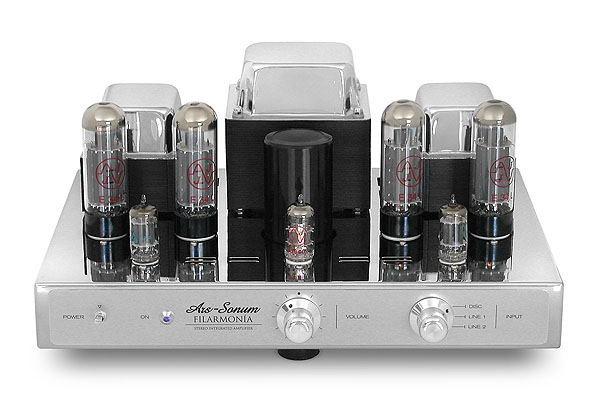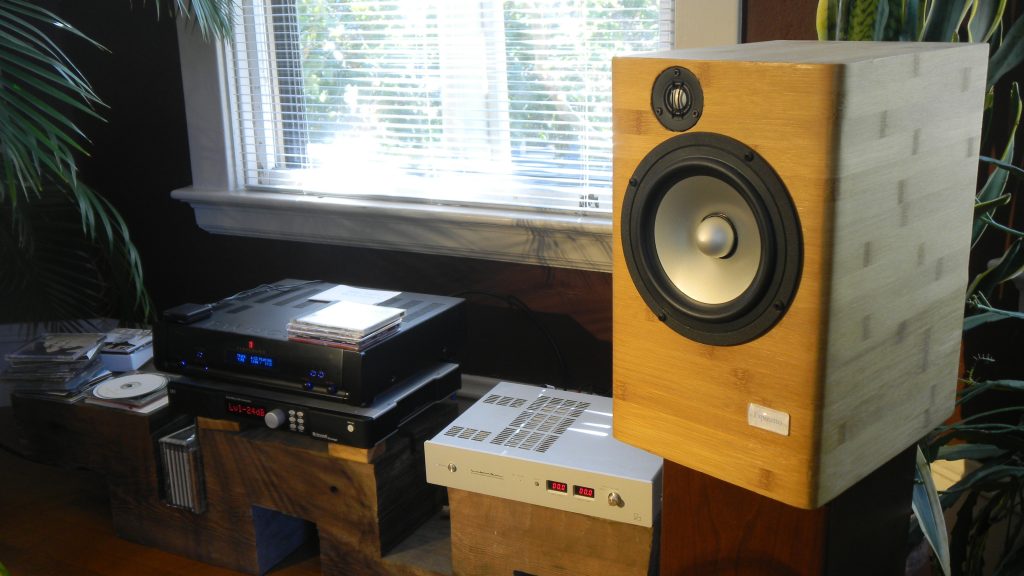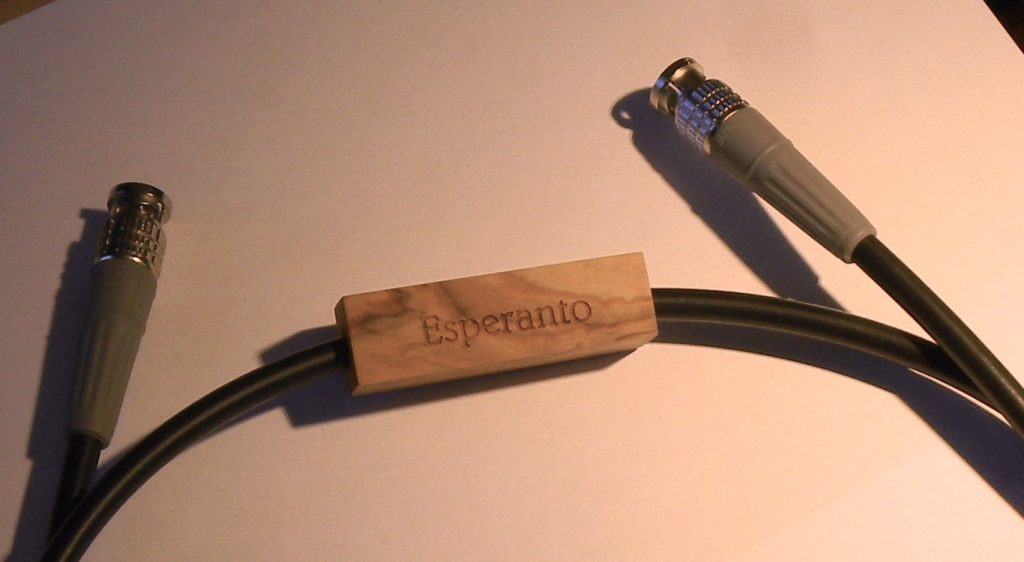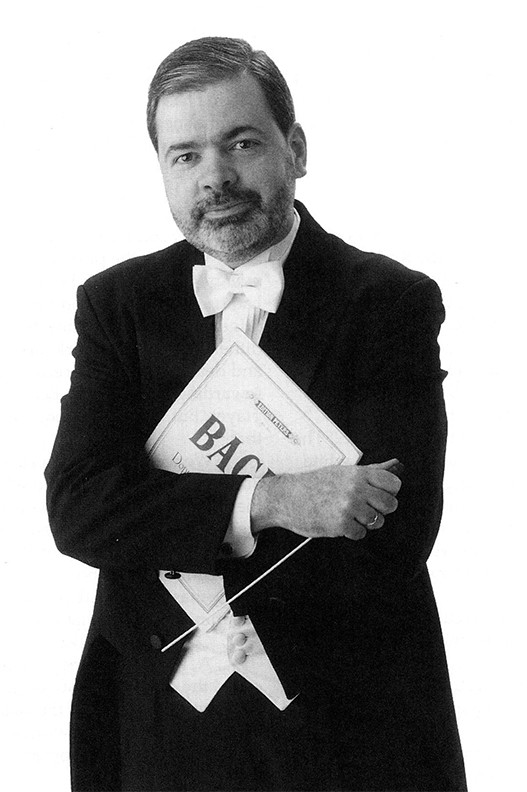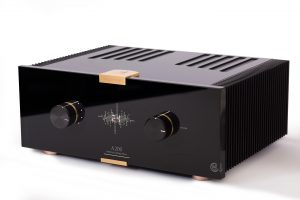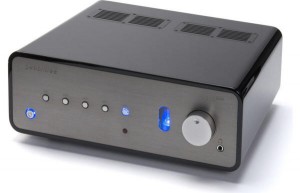John Marks essays the Ars-Sonum Filarmonia integrated in this article. In doing so, he's revisiting...he had given a very favorable evaluation of an earlier iteration of the Filarmonia some ten years ago, while writing for Stereophile.
An offer to Positive Feedback by long-time audio friend Rich Brkich of Signature Sound provided John with the opportunity to hear this new SK design. More than that, it also gave John an opening for reflecting on changes in the audio arts, their distribution, and the reviewing thereof over the past decade, and where this may be leading us.
In a recent conversation, John and I were speaking of the way that a given audio system might touch us deeply. He spoke of the fact that he and his girlfriend knew that feeling, one that he described as being "the shock of recognition."
Amen! It immediately reminded me of what happens within me in my fine photographic work, when I know that I've seen it, that powerful jolt of knowing that I am seeing to the heart of a moment photographically. When the artist, vision, and the instruments of craft are one, then greatness can happen.
The great photographer Edward Weston described it in his Daybooks as "the flame of recognition."
Exactly...this, and only this.
Audio is an independent art form, fully co-equal with its siblings. It is not subservient to other other art forms, particularly "live music," which is a performing mode. Various designs and approaches within the audio arts lead to different interpretations of musical possibilities in recordings, different flavors, and diverse pathways to heart and soul.
Herein is one such path to "the shock of recognition"; follow it to its end. See if its description calls to you.
Dr. David W. Robinson, Ye Olde Editor
Ars-Sonum's Filarmonía SK integrated amplifier is neither MQA-ready nor Roon-ready. Given what I read in the audio forums, it seems as though its not being MQA-ready will cause boatloads of listeners to read no further, only pausing to sigh as they cross the Filarmonía off their shopping lists.
Not only is the Filarmonía SK not MQA-ready and not Roon-ready; the Filarmonía does not respond to verbal commands delivered via Siri or Alexis. Even more to the point, the Filarmonía does not even come with a candy-bar-form-factor volume-only remote control!
The Filarmonía SK is a Spanish-made vacuum-tube integrated amplifier with a rated output of 30 Watts per channel into 8 Ohms. It measures 14.25 x 12 x 7 inches (W x D x H), and weighs a hefty 30 pounds. Be aware, please, that most of its weight is concentrated in the rear half of its chassis, and so the Filarmonía SK can be a "tippy" load while being repositioned or carried.
The front panel contains an of/off toggle switch for power and a blue pilot light; a volume-control knob, and an input-selector knob. The rear panel holds an IEC power-cord inlet; screw-clamp loudspeaker binding posts sourced from Cardas; and three pairs of high-quality input jacks and one pair of "Record Out" jacks. The front panel can be ordered in silver, black, or gold. One feature I like is that the labels for the input jacks are on the top panel, and not the rear panel.
The Filarmonía SK's United States MSRP is $4950. The importer is Rich Brkich of Signature Sound in Liverpool, NY. [http://sigsound.com/ars-sonum-filarmonia/] The importer's website includes a downloadable white paper touching upon the circuit design and enumerating the ways in which the new model improves upon past models.
I recommend that people who are very interested in the details of the circuit design consult the importer's website. I think it sufficient for me to say that the Ars-Sonum amplifier circuit is not the very familiar "Ultralinear" design of D.T.N. Williamson, but rather a proprietary circuit employing a screen-grid regulated pentode tube in push-pull disposition, with very low global negative feedback, and which does not require user adjustments to the bias settings of the tubes. It is claimed that the Filarmonía SK usually operates in Class A, going into Class B only for brief dynamic excursions.
Ars-Sonum has built for it output transformers of its own design, and uses premium parts throughout. Tubes come in numbered matched pairs; a white glove is included. Parts upgrades that were options on previous iterations come standard on the new one, which cancels out a good part of the price increase since Ars-Sonum first entered the US market 10 years ago.
The current version of the Filarmonía SK is an upgrading of an amplifier I wrote about (very favorably) in my column in Stereophile magazine in 2007. While that coverage was in 2007, Ars-Sonum began production of the first Filarmonía in 2000. Therefore, this amplifier has had a very robust production history, and the longevity of a classic. As a measure of its acceptance in its home country, Spanish composer, conductor, and musician Jordi Savall owns a Filarmonía amplifier. To restate, my coverage in Stereophile of the earlier version of this amplifier was 10 years ago.
By some synchronicity, also ten years ago, Apple Corporation began shipping the original iPhone. It would be hard to imagine two products from the modern era that are more different, both of which can play music.
The iPhone can store a huge number of lossily-compressed digital music files; today's versions can also access streaming music from services such as Tidal and Pandora. How the iPhone has changed the place of recorded music in our lives (or perhaps rather, how the iPhone has changed how we relate to recorded music) is something music lovers should ponder seriously; are convenience and portability really the cardinal virtues; or, are we losing more than we are gaining?
I think that designer Ricardo Hernandez has a finely-tuned sense of what his customers want. The combination of vacuum tubes in a high-quality integrated amplifier has the virtue of simplicity; it also makes a statement that the ideal customer for this product may be a music lover with a sense of history and a sense of style, who wants to hear the solid middles of the notes with no "enhanced edge definition" (to mix audio and video metaphors). While this is a line-level design, LP lovers can plug their favorite phono amp into one of the RCA line-level inputs and enjoy the loveliness of the Filarmonia SK, as well.
An equally-ideal customer would be a music lover in the other direction: who does not own a turntable, is not buying records, and who has a whole-home Sonos network setup, but who also wants to use a Sonos Bridge or an Audioengine B1 Bluetooth Music Receiver to play Tidal's on-demand streaming music through an amplifier and speakers, for a more dedicated or focused listening experience.
I think that Sonos (and its competitors) is great for spreading music throughout the house, when the music is meant to serve as an accompaniment to other activities, such as reading or knitting, housework, or socializing. But I think that when the focus shifts, and one is listening to music for its musical values in and of itself, it makes sense to have a dedicated "listening" system with real loudspeakers and associated components. I know that people in fact often run parallel setups: one for music to accompany other activities, and one to enjoy the music for itself. (I try to avoid using the shopworn phrase "critical listening." Anyway, I think that the phrase "careful listening" is closer to reality.)
In any case, the customer also enjoys the wonderful retro vibe this amp gives off just by its industrial-design statement. The Filarmonía SK was in the living room for a few months that also saw various tradespeople trooping in and out, putting in new insulation and windows and wallboard and so forth, and those who noticed the amplifier, all thought that it was a near-antique. "They still make those?" was the usual disbelieving reaction from non-audiophiles.
I do think that the Ars-Sonum Filarmonía SK is "format agnostic" as between LPs, optical digital, and streaming; but I also think that it is a distinctly individual product. I think that some people will love it, while others might not get it so much. I have been trying to put my finger on why this should be so, and here is what I have come up with.
Rock-music legend and record producer and engineer Chris Huston [link: https://en.wikipedia.org/wiki/Chris_Huston] once asked me the provocative question, "Should a loudspeaker have a personality?"
I found that somewhat of a daunting question, in that as an engineer or a record producer, Huston had worked with The Young Rascals, Led Zeppelin, The Who, Todd Rundgren, James Brown, Ben E. King, Patti LaBelle, Eric Bourdon, War, and others. I did not want to appear to be anything less than "The Model of a Modern Major Audio Writer;" but, I also had to be myself.
I replied, "Yes, a loudspeaker should have a personality."
I know full well that the Audiophile Orthodox answer is, "No, not at all—a loudspeaker is supposed to be a neutral transmitter." But in real life, every loudspeaker I have ever heard has been a compromise (even if the only thing that gets compromised is affordability; but I have never heard that loudspeaker, either).
When a loudspeaker designer chooses this, he has to give up that. So, seeing as somebody has to prioritize which things to keep and which ones to give up, most loudspeakers do seem to end up with a "personality" that reflects their designers' values.
In my experience, if a loudspeaker seems to be designed to have no personality, designed to be more "neutral" than Sweden-raised-to-the-power-of-Switzerland, the cure often seems worse than the disease. Such "excessively neutral" loudspeakers often seem to lack color and life, the audible equivalent of gray walls dimly illuminated by bluish fluorescent bulbs.
It's funny to be thinking about "loudspeakers with personalities," given that just yesterday, John Atkinson asked me to write a reminiscence of Richard Shahinian for Stereophile magazine. Dick Shahinian's loudspeaker designs have huge personalities, none more so than the Diapason. But Dave (and more recently, Daryl) Wilson's loudspeakers also usually have had large personalities, and the same can be said of the offerings from Wilson Benesch, Vivid Audio, Quad (electrostatics), and many other fine designs.
So, the first thing I want to say about my listening impressions is that in my view, the Filarmonía SK definitely is an amplifier with a personality.
Now, I can imagine a state of affairs where a person says, "I love the sound of my loudspeakers, and I recognize that my loudspeakers are the result of a design process involving tradeoffs, with the result that Wilson Audio and Wilson Benesch are not likely to be mistaken for each other, and I am content with the choice I made; but I do not want an amplifier adding its own personality to the mix—I want a "neutral" amplifier. Well, OK then.
I do think that the range of loudspeakers does contain a wider spectrum of "personalities" than modern amplifiers. I am old enough to recall the truism that loudspeakers with the "New England Sound" were a bit reticent on top, because young loudspeaker designers could not afford the good seats down front in Symphony Hall, Boston (as a result sitting under the balcony, and not getting the first reflections from the ceiling in front of the stage); while the "West Coast Sound" loudspeaker designers made brighter-sounding loudspeakers, because they hung out in rock-and-roll recording studios. (From the perspective of decades later on, all that sounds like pure piffle.)
I think that high-end amplifiers today are, for the most part, more alike than different; but there remains the Great Divide between solid-state amplifiers (now itself divided into analog solid-state versus switching [digital] designs), and vacuum tubes.
So, yes, the Ars-Sonum Filarmonía SK definitely is an amplifier with a personality, and that personality strikes me as warmly inviting, and over and above that, it is all about tone and tonal richness. Especially the midrange tones of human voice and orchestral strings; but also piano, and jazz trumpet and jazz saxophone.
By the way, Rich Brkich enthusiastically recommends upgrading the Filarmonía's stock power cord to a Cardas power cord. He sent me a Cardas Clear Beyond Power Cord (price depends on length). I found the Cardas Clear Beyond to make a obvious and meaningful difference in the overall sonic presentation. The noise floor seemed lower (it was already low), the music had more presence, and the inner voices of things like a string quartet recording seemed easier to untangle and follow.
Earlier today, I was listening to the Anonymous 4's Christmas Music from Medieval Hungary (CD Harmonia Mundi HCX 3957139), which documents music from the twelfth to the sixteenth centuries sung by a female a cappella vocal quartet. Gloriosky, does the Filarmonía SK just love female voices!
Oops, I take that back. Gloriosky, does the Filarmonía SK just love human voices!
My Musically Astute Friend wanted to hear more Christmas music, and what was both nearest to hand and also in the top tier of quality, respecting recording technique and performance, was John Atkinson's recording Comfort and Joy: Volume One, sung by the Minnesota-based male a cappella vocal ensemble Cantus. (CD Cantus Recordings CTS-1204) Track 1 is a Nativity Plainchant, "Puer natus est." At the first sound of the voices, we experienced what I call The Shock of Recognition. The male voices and the room they were singing in sounded so real.
Comfort and Joy: Volume One is a Christmas recording you really should check out, if you like Christmas music. A recording engineer I played some of its tracks for ended up buying the CD, later telling me that John Atkinson's recording of Cantus' performance of Morten Lauridsen's "O Magnum Mysterium" was the best choral recording he had ever heard. Comfort and Joy: Volume One is available from third-party sellers on Amazon, or as part of a six-CD set from Stereophile's online store.
Another vocal-forward recording that the Filarmonía SK loved was Julie London's duos with acoustic guitar, Lonely Girl. (CD Rev-Ola REV 197.) Lonely Girl (with Al Viola on guitar) was London's second album, originally released in 1956, which helped London become the best-selling female vocalist in the US for 1956, 1957, and 1958. (Between December 1955 and December 1958, London released eight LPs.) Lonely Girl's title track is a bit dopey, but other tracks include covers of Great American Songbook standards by Rodgers and Hart, Irving Berlin, and Johnny Mercer.
London knew that she had a small voice, and so she made sure to get close to the microphone, which given the time, could have been a large-diaphragm condenser such as made by Neumann, Telefunken, or AKG; but it also could have been a classic RCA ribbon mic such as a BX44. In either case, London made sure not to overwhelm or, in the case of a ribbon, damage the microphone by belting songs out. The combination of a close mic position and intimate delivery set a standard for sultry female vocals that is still prevalent today.
The Filarmonía SK and Lonely Girl fit together like hand in glove. This album is more pensive and less energetic that London's first one, and the Filarmonía SK just luxuriated in the silences between notes as much as in the purr of London's lower register. The combination of acoustic guitar and subdued female vocal could probably be reproduced at near-realistic levels with about three Watts. So, the 30-Wpc Filarmonía SK was cruising along on cruise control without a care in the world.
I used the Filarmonía SK with prototype loudspeakers that I was a co-designer of, in part because I am very familiar with them. My company (whose only products so far are digital cables S/PDIF, AES/EBU, and Word Clock) is called Esperanto Audio, so the loudspeaker is called the Esperanto Parolanto, an attempted witticism in the constructed international auxiliary language Esperanto. It means "Esperanto Speaker." The Esperanto Parolanto is a vented two-way with an efficiency circa 86dB.
Upon occasion, I like to blow out the cobwebs in a stereo system by running the long version of the Ayre/Cardas Irrational! But Efficacious system enhancement CD's Sine Wave Sweep. When I did so with the Filarmonía SK, I noticed that the woofers were flapping around somewhat more than they had on a much more expensive ($15,000) 125Wpc solid-state amplifier. I took this to mean that the damping factor of the Filarmonía SK was less robust that an amp costing three times as much (hardly a surprise); and also that the very large solid-state amp could deliver more current; again, hardly a surprise.
I turned the volume knob up to about the 12 o'clock position, and cued up Pierre Boulez' excellent Mahler Symphony No. 5 with the Vienna Philharmonic. (Deutsche Grammophon Japanese Domestic Market HMCD UCCG-90455) The Filarmonía SK played loudly, but I think with not enough composure. However, I think that that should not automatically damn the product. Loudspeakers with greater efficiency would probably have worked out better in the case of that CD and volume setting.
Furthermore, when, as a sanity check, I played the opening of the first track of Steely Dan's Aja (Pioneer Japanese Domestic Market CD 20P2-2055), all was well, all was well. It was more than well; it was very enticing! "Black Cow's" iconic bass… um, it's not so much a "line" as a series of gestures, was solidly punchy, yet fluid. The guitar and electric piano were piquant. The vocal entry showed off the Filarmonía SK's rewarding image specificity. I truly wanted to keep listening, rather than get back to writing.
Which I think is the crux of the matter: for a given expenditure of money, do you get an amplifier that makes you want to keep listening?
Rather than make a decision based on a review, no matter how positive, I would recommend that anyone who is curious or interested get in touch with Rich Brkich, who probably knows as much about system synergy for the Filarmonía SK as does anyone. I am sure that for the right listener with the right situation and tastes and associated equipment, the Filarmonía SK can be a "buy it once and buy it right" purchase.
And for those with larger rooms or who want more oomph when only Mahler will do, Ars-Sonum offers an amplifier, the Gran Filarmonía , that costs almost twice as much, but which also has twice as much power.
It's not my job to hand out free advice to audio companies, but were I importing this amp, I'd make a beeline to the nearest Design Within Reach store. Sure, bring along a Rega turntable and some small Harbeth loudspeakers and some nice vinyl with your favorite compact phono amp. Set up a little listening area with some nifty Mid-Century Modern lounge chairs....
My personal intuition is that the vinyl revival is only partly a manifestation of "trendier than thou." I think that in part it is an instinctive rebellion against the idea of presenting music in every possible circumstance and situation, but largely wrenched out of context. Especially the social context of listening together to loudspeakers, rather than being isolated in our own little playlists by earbuds.
The Ars-Sonum Filarmonía SK is an "old-school" product, painstakingly made with modern parts and methods. It definitely has its own personality; but if its personality and yours mesh, I think you will be very happy.
Ars-Sonum Filarmonía SK
Retail: $4950
US Distributor
Rich Brkich
Signature Sound
315.622.4137
http://sigsound.com/contact-and-about-us/contact-form/




